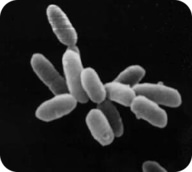5.6: Archaea
- Page ID
- 2942

What organisms can grow in the hot springs of Yellowstone National Park?
In the 1970s, a new group of organisms was identified. Unlike other organisms, these organisms could thrive in temperatures near 100ºC, the boiling point of water! This new group of organisms was named archaea.
What are Archaea?
For many years, archaea were classified as bacteria. Like the bacteria, archaea lacked a nucleus and membrane-bound organelles and, therefore, were prokaryotic cells. However, when scientists compared the DNA of the two prokaryotes, they found that there were distinct differences. They concluded that there must be two distinct types of prokaryotes, which they named archaea and bacteria.
Even though the two groups might seem similar, archaea have many features that distinguish them from bacteria:
- The cell walls of archaea are distinct from those of bacteria. While bacteria have cell walls made up of the polymer peptidoglycan, most archaea do not have peptidoglycan in their cell walls.
- The plasma membranes of the archaea are also made up of lipids that are distinct from those in bacteria.
- The ribosomal proteins of the archaea are similar to those in eukaryotic cells, not those in bacteria.
Although archaea and bacteria share some fundamental differences, they are still similar in many ways:
- They both are single-celled, microscopic organisms that can come in a variety of shapes (Figure below).
- Both archaea and bacteria have a single circular chromosome of DNA and lack membrane-bound organelles.
- Like bacteria, archaea can have flagella to assist with movement.

Obtaining Food and Energy
Most archaea are chemotrophs and derive their energy and nutrients from breaking down molecules in their environment. A few species of archaea are photosynthetic and capture the energy of sunlight. Unlike bacteria, which can be parasites and are known to cause a variety of diseases, there are no known archaea that act as parasites. Some archaea do live within other organisms. But these archea form mutualistic relationships with their host, where both the archaea and the host benefit. In other words, they assist the host in some way, for example by helping to digest food.
Reproduction
Like bacteria, reproduction in archaea is asexual. Archaea can reproduce through binary fission, where a parent cell divides into two genetically identical daughter cells. Archaea can also reproduce asexually through budding and fragmentation, where pieces of the cell break off and form a new cell, also producing genetically identical organisms.
Further Reading
Summary
- Archaea are prokaryotes, but they differ from bacteria in their DNA and biochemistry.
- Most archaea are chemotrophs, but some are photosynthetic or form mutualistic relationships.
- Archaea reproduce asexually through binary fission, fragmentation, or budding.
Explore More
Use the resource below to answer the questions that follow.
- Introduction to the Archaea at http://www.ucmp.berkeley.edu/archaea/archaea.html.
- What are the three domains of life?
- Why was the name Archaeabacteria misleading?
- What is bacteriorhodopsin? What is the role of bacteriorhodopsin in ATP production?
Review
- Describe two ways archaea are different from bacteria?
- How can archaea reproduction be distinct from bacterial reproduction?
- How do most archaea obtain energy?

